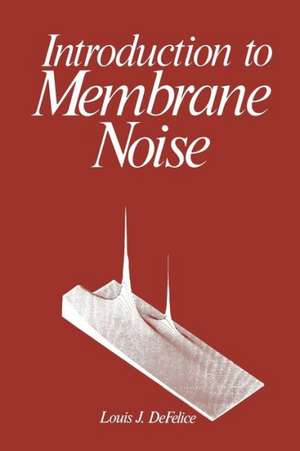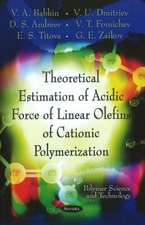Introduction to Membrane Noise
Autor Louis J. DeFeliceen Limba Engleză Paperback – 22 oct 2011
Preț: 399.67 lei
Nou
Puncte Express: 600
Preț estimativ în valută:
76.48€ • 81.78$ • 63.76£
76.48€ • 81.78$ • 63.76£
Carte tipărită la comandă
Livrare economică 18 aprilie-02 mai
Preluare comenzi: 021 569.72.76
Specificații
ISBN-13: 9781461331377
ISBN-10: 1461331374
Pagini: 520
Ilustrații: 516 p. 53 illus.
Dimensiuni: 152 x 229 x 27 mm
Greutate: 0.69 kg
Ediția:Softcover reprint of the original 1st ed. 1981
Editura: Springer Us
Colecția Springer
Locul publicării:New York, NY, United States
ISBN-10: 1461331374
Pagini: 520
Ilustrații: 516 p. 53 illus.
Dimensiuni: 152 x 229 x 27 mm
Greutate: 0.69 kg
Ediția:Softcover reprint of the original 1st ed. 1981
Editura: Springer Us
Colecția Springer
Locul publicării:New York, NY, United States
Public țintă
ResearchCuprins
Animal Electricity.- 1. Newton’s Opticks and Ganot’s Physics.- 2. Pre-Galvani Experiments and the Leyden Jar.- 3. Benjamin Franklin and the Magic Square.- 4. Volta’s Electrophorus.- 5. Galvani’s First Experiment.- 6. Galvani’s Second Experiment.- 7. Animal Electricity Described in Ganot’s Physics.- 8. The Voltaic Pile and the Electric Fish.- 9. Examples.- 10. Models and Analogies Used in Electrophysiology.- Basic Electrophysiology.- 11. Salt Water Conducts Electricity.- 12. Resistance of Salt Water.- 13. How Ions Move: The Flux Equation.- 14. First Application of the Flux Equation: The Nernst Relation.- 15. Second Application of the Flux Equation: The Diffusion Potential.- 16. An Example of the Nernst Relation: The AgCl Electrode.- 17. An Example of the Diffusion Potential: The Agar Bridge.- 18. Steady Current in Ionic Solutions.- 19. The Integral Resistance.- 20. The Flux Equation and Potential Profile.- 21. An Example: The Glass Microelectrode.- 22. The Effect of Pressure on Integral Resistance.- 23. Membrane Rectification and Reactance.- 24. Inductance and Capacitance: Time Domain.- 25. Fourier Transformation: The Delta function.- 26. Inductance and Capacitance: Frequency Domain.- 27. Equivalent Circuits of Membranes.- 28. Equivalent Circuits of Cells.- 29. Cable Equation: Passive Properties.- 30. Equivalent Circuits and Active Membranes.- Basic Circuit Theory.- 31. Voltage and Current Sources.- 32. Frequency Composition of Signals.- 33. The Mean and the Variance.- 34. Spectral Density and Rayleigh’s Theorem.- 35. Spectral Density and Source Impedance.- 36. Examples.- 37. Power Spectral Density.- Noise Analysis.- 38. Filtering.- 39. Measurement of Spectral Density.- 40. Effect of Filter Bandwidth.- 41. The Convolution Theorem.- 42. The CorrelationTheorem.- 43. Measurement of Correlation Functions.- 44. Correlation Functions: Examples.- 45. Integral Spectra.- 46. Relationship between the Integral Spectrum and the Correlation Function.- 47. Examples of Integral Spectra.- 48. Inversion of the Integral Spectrum.- 49. The Integral Spectral Density.- 50. Multiple Lorentzians.- 51. Examples of the Inversion Formula.- 52. Correlation Functions of Filtered Noise.- 53. The Exponential Integral.- 54. The Effect of Finite Time Measurements.- 55. Examples of Error Calculations.- 56. Comparison of Errors in Correlation Functions, Integral Spectra, and Spectral Densities.- 57. Correcting Correlation Functions for ac Coupling.- Noise Sources.- A. White Noise.- 58. Johnson Noise.- 59. Derivation of the Nyquist Formula.- 60. Nyquist Formula for an Arbitrary Impedance.- 61. Quantum Theory Formulation of Nyquist’s Equation.- 62. Johnson Noise and the Nernst Equation.- 63. Measurement of Johnson Noise.- B. I/f Noise.- 64. Excess Noise in Carbon Resistors.- 65. Excess Noise Depends on Current.- 66. The Effect of Resistor Size on Excess Noise.- 67. Resistor Noise: A Selected Chronological Bibliography.- 68. Excess Noise in Ionic Conductors.- 69. Excess Noise in Lipid Bilayers.- 70. I/f Noise and Concentration Gradients.- 71. Theories of Excess Noise.- C. Lorentzian Noise.- 72. The Two-State Channel.- 73. The Relationship between Channel Noise and Current Noise.- 74. Two-State Channels in Series.- 75. Bernoulli’s Distribution for Two Independent Two-State Subunits.- 76. Correlation Functions for Two-State Channels in Series.- 77. The Relationship between Channel Models and Kinetic Schemes.- D. Campbell’s Theorem.- 78. The Mean and the Variance.- 79. Noise Spectra from Campbell’s Theorem.- Membrane Impedance.- 80. EquivalentCircuits of Kinetic Equations.- 81. The Small-Signal Impedance of a Population of Ionic Channels.- 82. The Small-Signal Impedance of Channels in a Membrane.- 83. Transient Response to the RrLC Circuit.- 84. Voltage Noise from Channels Embedded in a Membrane.- 85. The Equivalent Noise Source for Channel Noise.- 86. Current Noise Parameters Derived from Voltage Noise and Impedance.- 87. Small-Signal Impedance of the HH-Axon Membrane.- 88. The Heaviside Line and the RrLC Cable.- Experimental Results.- 89. Miniature End-Plate Potentials.- 90. Acetylcholine Noise.- 91. Other Types of Chemically Induced Noise.- 92. ACh Noise under Voltage Clamp.- 93. Other Types of Chemically Induced Noise under Voltage Clamp.- 94. Effect of Procaine on ACh Noise.- 95. Effect of Dithiothreitol on ACh Noise.- 96. Current Noise from Denervated Skeletal Muscle.- 97. Single-Channel Currents.- 98. Ion Flow through the ACh Channel. A Noise Analysis.- 99. Glutamate Noise I.- 100. Glutamate Noise II.- 101. Electrical Noise from Motoneurons.- 102. Excitability Noise in Neurons.- 103. Nerve Membrane Noise.- 104. Voltage Noise from the Node of Ranvier.- 105. The Squid Giant Axon.- 106. Current Noise from the Squid Giant Axon.- 107. Current Noise from the Node of Ranvier I.- 108. Current Noise from the Node of Ranvier II.- 109. Small-Signal Impedance of Nerve and Heart Cell-Membranes.- 110. Photoreceptor Noise. An Early Study.- References.










